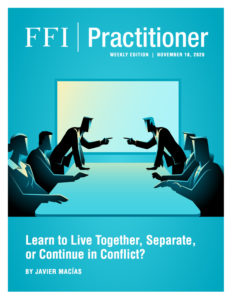
View this edition in our enhanced digital edition format with supporting visual insight and information.
Thanks to Javier Macías, a member of the FFI Iberoamérica Virtual Study Group, for this article exploring three options available to consultants working with clients experiencing chronic conflict. This article continues the series of bilingual editions by members of the FFI Iberoamérica Virtual Study Group, and you have your choice of reading it in English or in Spanish!
What options are available to a family that is constantly in conflict?
We can say that there are three:
- Learn to live together
- Separate
- Continue in conflict
Those might appear to be three clear options, yet trying to put any of them into practice is not so simple.
One approach that a family business consultant might take would be to help the family make a firm decision: learn to live together, separate, or continue in conflict. Then, the consultant might offer various services to the client based on whichever goal is chosen. However, given that the consultant was likely engaged to help resolve the conflict, in one way or another, it is unlikely that he or she would advocate for the third option. Thus, the first step when working with clients who are locked in conflict will be to gain the family’s commitment to resolve its situation (A or B).
In many cases, consultants take on an assignment presupposing that family members desire a reconciliation. Yet this isn’t always the case. Some conflicts are misunderstandings among family members who strive hard to find a solution, while some other conflicts may call for a separation, but the family doesn’t know how to express this.
Therefore, the first important clarification to make is, “Are we staying together or separating?”
Different family conflicts might have similar roots, but the consultant must take different approaches to solve them.
Let’s talk about Juan, as an example. He left his hometown to obtain a master’s degree at university in Chicago. After graduating, he found work in large corporations or professional firms. He explored the world and came to know other people and other ways of doing things. When Juan returned to the family business, he expressed loyalty his family’s legacy and values.
Juan’s father, Antonio, was perplexed by the ideas that Juan introduced to the company. For Antonio, Juan is still a child who now happens to respond to his father in a deeper voice and with adult arguments. This dynamic causes Antonio to respond inconsistently to Juan’s new ideas. As a result, Juan reacts explosively to the inconsistencies of his parents. The conflict that has arisen between Antonio and Juan is one between tradition and innovation.
In other cases, conflict could originates from family members’ total dissatisfaction with having to work with each other. This is Román and Alberto’s case: brothers who have grown up in the same family, but whose experiences have marked them differently. These two brothers have grown up so differently, and they have treated each other poorly for so long, that reconciliation now seems impossible. The family commitment to continue working together only provokes irritation, antagonism, and the desire to be rid of one another. Both sides know that the time has come to separate, but they either lack the courage to take that step for themselves or don’t know how.
In general, family conflicts have two basic ingredients: 1) the need to belong and 2) the need to differentiate. One precedes the other. A child feels security in belonging to a family and needs to be loved, respected, and valued. As adolescents grow, they begin to challenge that security by differentiating themselves from the family and seeking affiliation with peer groups in school and in their community.
Mature adults reach an accord between the family and themselves, in which they negotiate a balance between what their loved ones expect of them and the happiness they hope to find in life. Some adults manage to negotiate an optimal balance between the need to belong to their families of origin and the need to differentiate from them. Sometimes this negotiation means to live and work together in the family business, assuming clear boundaries between family and individual, and between family and business. At other times it means breaking up business relationships while maintaining successful family relations from a distance.
When the family has decided to continue together, the consultant can only help them achieve that goal if everyone plays their part. What frequently occurs in family conflicts is blaming one person or one group: “They got us in this situation, so they’re the ones who have to change.” The goal-oriented consultant should avoid judging families’ behaviors or participate in the search for the guilty or the victims. If a consultant commits the error of accepting the approval of one side of the family conflict, he or she risks losing the trust of family members on the other side, thus losing the capacity to help the family.
A useful guideline is to establish a code of conduct in the family that bans blaming others or complaining. Those behaviors only fuel conflict with no benefit for anyone. If complaints continue to violate the code, the family may need to revisit the first decision of all: “stay together or split up?”
When making the family decision to learn to live together, it can be useful to ask about the function of conflict in the family system. A question that therapists often ask in families with an “identified patient”1 is, “What function does this symptom serve for the family? (Kaye, 1996). In other words, how does the symptom enable the family to go on functioning? In the case of a family in conflict about working together, how is this conflict useful for them?
Little by little, the consultant advances with the family toward its ability to change how the members describe their relationships to one another. When consultants begin to work with a family, they usually encounter a dominant narrative, that is to say, how the family defines what’s going on. A dominant narrative is not in itself dysfunctional, unless it reduces the family’s available decision-making options.
When the consultant works with the family members to help them live and work together, their work will consist of creating a context in which the family members can change their narrative toward new ways of describing their situation. That revised narrative allows for more options in their decision-making. This new context will allow family business members to better negotiate their needs of belonging and differentiation.
However, some family members aren’t so successful. They remain trapped in the need to belong, loyal to invisible ties and emotionally attached to their family of origin’s needs (D’Ascenzo, 2016). They meet the family firm’s expectations of them with little or no possibility of having a life of their own. When that negotiation fails within the family of origin, the only way out may be to break with the family of origin, pursue some independent project at the margin of the business, break up the business, or sell shares to third parties or to another branch of the family.
One individual, group, or branch of the family may have decided to separate. In this case, the agreement of all is not so necessary. The fact that one party has taken the decision to break off is enough to begin the work in that direction. The part of the family that chooses to remain might oppose it, make things difficult, or even offer alternatives, but the decision isn’t in their hands. If the conviction to separate is definite, it is sufficient that one of the parties manifests it and persists in its objective.
In summary, the consultant that begins to work with a family in constant conflict may find it useful to begin the work by offering them three options:
- Learn to live together: this option implies the agreement of all family members.
- Separate: this only requires the will of one family member, group, or branch.
- Continue in conflict: in which case, they likely don’t need to hire a family business consultant.
Establishing these three options from the start and negotiating with the family can bring the trust needed to succeed.
Finally, I would like to point out that a successful outcome does not necessarily mean that the whole family remains together in the family business. In my opinion, success is achieved when the entire family makes a firm decision to move forward. The most important outcome for me is the professional and personal growth of every family member, either learning to live together in the organization, separating, or even selling the business.
References
D’Ascenzo, I. (2014). Terapia individual sistémica con jóvenes adultos en etapa de desvinculación. Redes: revista de psicoterapia relacional e intervenciones sociales, (30), 39-56.
Kaye, K. (1992). The kid brother. Family Business Review, 5(3), 237-256.
About the Contributor

Javier Macías, FFI Fellow, teaches and studies human relations management, family communication and family enterprise continuity. He is an active consultant, researcher and speaker. Currently he serves on advisory boards and family councils of several companies in Europe, South-America, and Middle-East. He teaches Entrepreneurship and Family Business in EAE Business School, Barcelona.

View this edition in our enhanced digital edition format with supporting visual insight and information.



